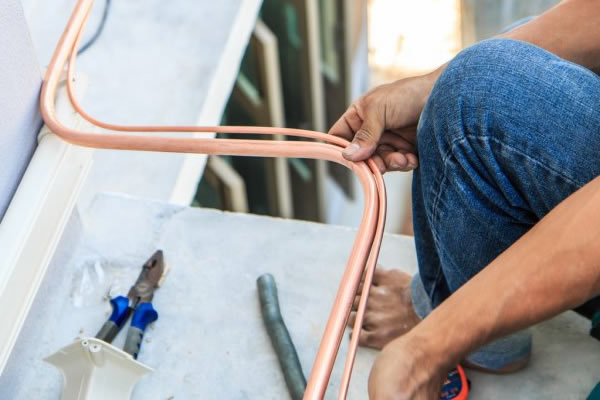Adherence to the New System:
· Type of Refrigerant:
Refrigerants like R-410A and R-32, which function at higher pressures than R-22, are frequently used in modern air conditioners. Your current pipes might not be able to handle the pressure and chemical characteristics of more recent refrigerants if they were made for R-22. Examine the new system’s specifications and contrast them with those of the pipes that are currently in place.
· Pipe Dimensions:
For proper refrigerant flow, the pipe size must match the new unit’s specifications. Mismatched pipe sizes might result in system failure, excessive noise, or decreased efficiency. To find out if the pipes in your air conditioner are the right size, check the manufacturer’s instructions.
Physical Inspection to Evaluate the Pipes’ Condition
Examine the pipes visually for any obvious indications of damage, including:
- Corrosion: Potential leaks and compromised structural integrity are indicated by corrosion.
- Dents or kinks: This may limit the flow of refrigerant and lower efficiency.
- Holes or Cracks: Even minor breaches have the potential to jeopardize the system as a whole.
Contamination and Cleaning:
The new system may become contaminated by any leftover oil, moisture, or debris in the pipes if they have been in use. To get rid of these impurities, “flushing,” or thorough cleaning, is necessary. However, the pipes must be structurally good for flushing to work.
Assessing the Insulation and Installation:
Insulation for Pipes:
Condensation and energy loss are avoided with proper insulation. Examine the insulation’s current state:
- Broken or Absent Insulation: To guarantee effectiveness, it must be replaced.
- Thickness: For best results, it must satisfy the new system’s specifications.
Installation Path:
Determine if the new air conditioner’s installation requirements can be met by the current pipe route. Installing new plumbing might be more sensible if significant modifications are needed.
Pressure Testing:
One of the most important steps in assessing the appropriateness of the current pipes is performing a pressure test. In order to check for leaks and make sure the pipes can handle the working pressures of the new refrigerant, this test entails pressurizing them with nitrogen gas. The necessity for replacement is indicated by any leakage or incapacity to retain pressure.
Take into account the Piping’s Age:
Even if they seem undamaged on the outside, older pipes are more likely to contain concealed wear and tear. It is advisable to replace pipes that are more than ten to fifteen years old, particularly when switching to a high-efficiency system that runs at higher pressures.
Consulting an Expert:
Compared to a do-it-yourself method, an HVAC specialist can more accurately evaluate the existing pipes’ safety, compatibility, and condition. Additionally, depending on the specifics of your system, they can conduct the required tests and offer suggestions.
Analysis of Cost vs. Benefit:
Although reusing pipes can save money upfront, take into account the risks:
- Decreased Efficiency: Poor system performance due to mismatched or deteriorated pipes might result in increased energy costs.
- Future Repairs: If compromised pipes fail sooner, expensive repairs or replacements may be necessary.
- Warranty Void: For warranty coverage, certain manufacturers want replacement pipework.
It could be more economical and dependable to install new pipes if the expense of guaranteeing compatibility and safety is considerable.
Environmental Considerations:
Reusing pipes minimizes waste and your installation’s environmental impact. These advantages could be offset, though, by inefficiencies and more maintenance if the pipes are reused in poor shape. When making a choice, try to strike a balance between cost, performance, and environmental impact.
Typical Situations:
· Switching to R-410A from R-22:
Due to pressure and chemical compatibility concerns, it is frequently required to replace the pipes when switching from an older system that uses R-22 to a more recent unit that uses R-410A.
· Small System Improvements:
Reusing the pipes is more practical when replacing an older unit with a comparable model that runs at comparable pressures and consumes the same refrigerant.
· Significant System Change:
Installing new pipes ensures optimal performance and reliability for major changes, including moving to a high-efficiency inverter system.
Frequently Asked Questions:
1. What Is Included In A Typical Air Conditioning Service?
Key parts of the system are usually examined cleaned, and repaired as part of a routine air conditioning service. Technicians check refrigerant levels, clean condenser and evaporator wires, examine electrical connections, clean or replace air filters, and examine the thermostat. They might also analyze the overall performance and efficiency of the system.
2. How Frequently Should My Air Conditioner Be Serviced?
The majority of HVAC professionals and manufacturers recommend having your air conditioner serviced at least once a year. To guarantee effectiveness and longevity, annual maintenance is advised for systems that are used often, such as in regions with high temperatures or commercial settings.
3. How Does The Performance Of Air Conditioners Depend On Refrigerant?
Since refrigerant absorbs and releases heat, it is essential for cooling. Compressor damage, frozen coils, and subpar cooling can result from low refrigerant levels. To ensure peak performance, experts look for leaks and replenish refrigerant during servicing.
4. Do Air Ducts Need To Be Cleaned While Being Serviced?
Although it is not included in annual maintenance, air duct cleaning should be done if blockages, mould, or an abundance of dust are detected. Clean ducts enhance system performance and indoor air quality, particularly in older systems in areas where dust and allergens are common.
5. How Much Does Air Conditioning Service Cost?
The location, system size, and service type all affect the price. Advanced repairs or services, including refrigerant recharge or circuit replacement, can be much more expensive than basic maintenance, which can cost anywhere from $75 to $200. Plans for yearly maintenance frequently offer greater value.

